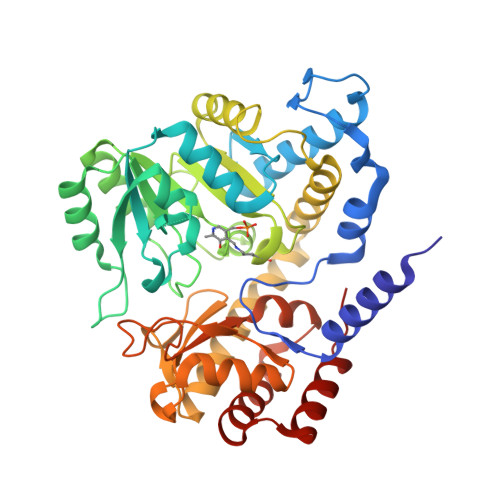Universality of critical active site glutamate as an acid-base catalyst in serine hydroxymethyltransferase function.
Drago, V.N., Phillips, R.S., Kovalevsky, A.(2024) Chem Sci 15: 12827-12844
- PubMed: 39148791
- DOI: https://doi.org/10.1039/d4sc03187c
- Primary Citation of Related Structures:
9BOH, 9BOW, 9BOX, 9BPE - PubMed Abstract:
Serine hydroxymethyltransferase (SHMT) is a key enzyme in the one-carbon metabolic pathway, utilizing the vitamin B 6 derivative pyridoxal 5'-phosphate (PLP) and vitamin B 9 derivative tetrahydrofolate (THF) coenzymes to produce essential biomolecules. Many types of cancer utilize SHMT in metabolic reprogramming, exposing the enzyme as a compelling target for antimetabolite chemotherapies. In pursuit of elucidating the catalytic mechanism of SHMT to aid in the design of SHMT-specific inhibitors, we have used room-temperature neutron crystallography to directly determine the protonation states in a model enzyme Thermus thermophilus SHMT ( Tth SHMT), which exhibits a conserved active site compared to human mitochondrial SHMT2 (hSHMT2). Here we report the analysis of Tth SHMT, with PLP in the internal aldimine form and bound THF-analog, folinic acid (FA), by neutron crystallography to reveal H atom positions in the active site, including PLP and FA. We observed protonated catalytic Glu53 revealing its ability to change protonation state upon FA binding. Furthermore, we obtained X-ray structures of Tth SHMT-Gly/FA, Tth SHMT-l-Ser/FA, and hSHMT2-Gly/FA ternary complexes with the PLP-Gly or PLP-l-Ser external aldimines to analyze the active site configuration upon PLP reaction with an amino acid substrate and FA binding. Accurate mapping of the active site protonation states together with the structural information gained from the ternary complexes allow us to suggest an essential role of the gating loop conformational changes in the SHMT function and to propose Glu53 as the universal acid-base catalyst in both THF-independent and THF-dependent activities of SHMT.
- Neutron Scattering Division, Oak Ridge National Laboratory Oak Ridge TN 37831 USA kovalevskyay@ornl.gov.
Organizational Affiliation:




















